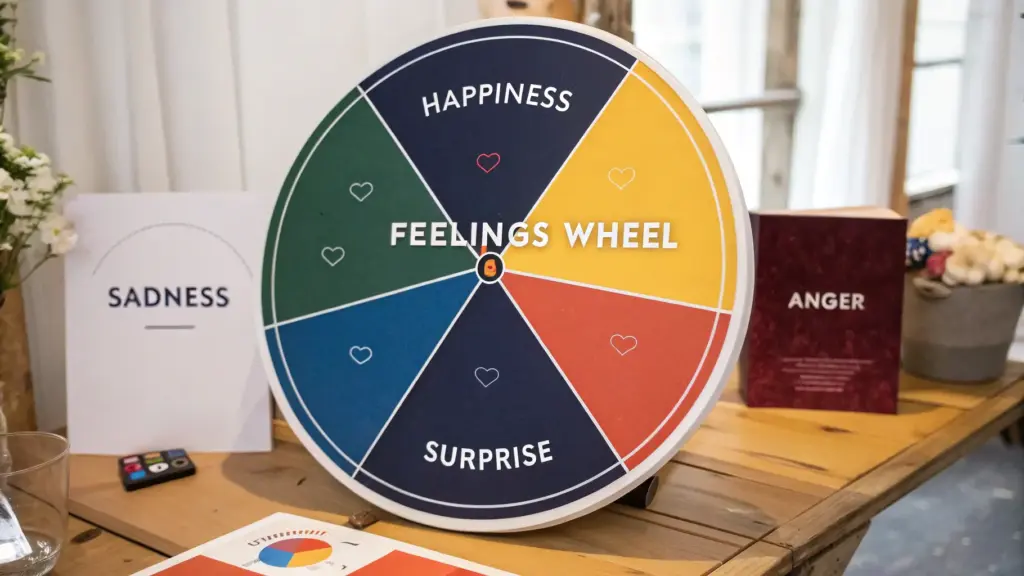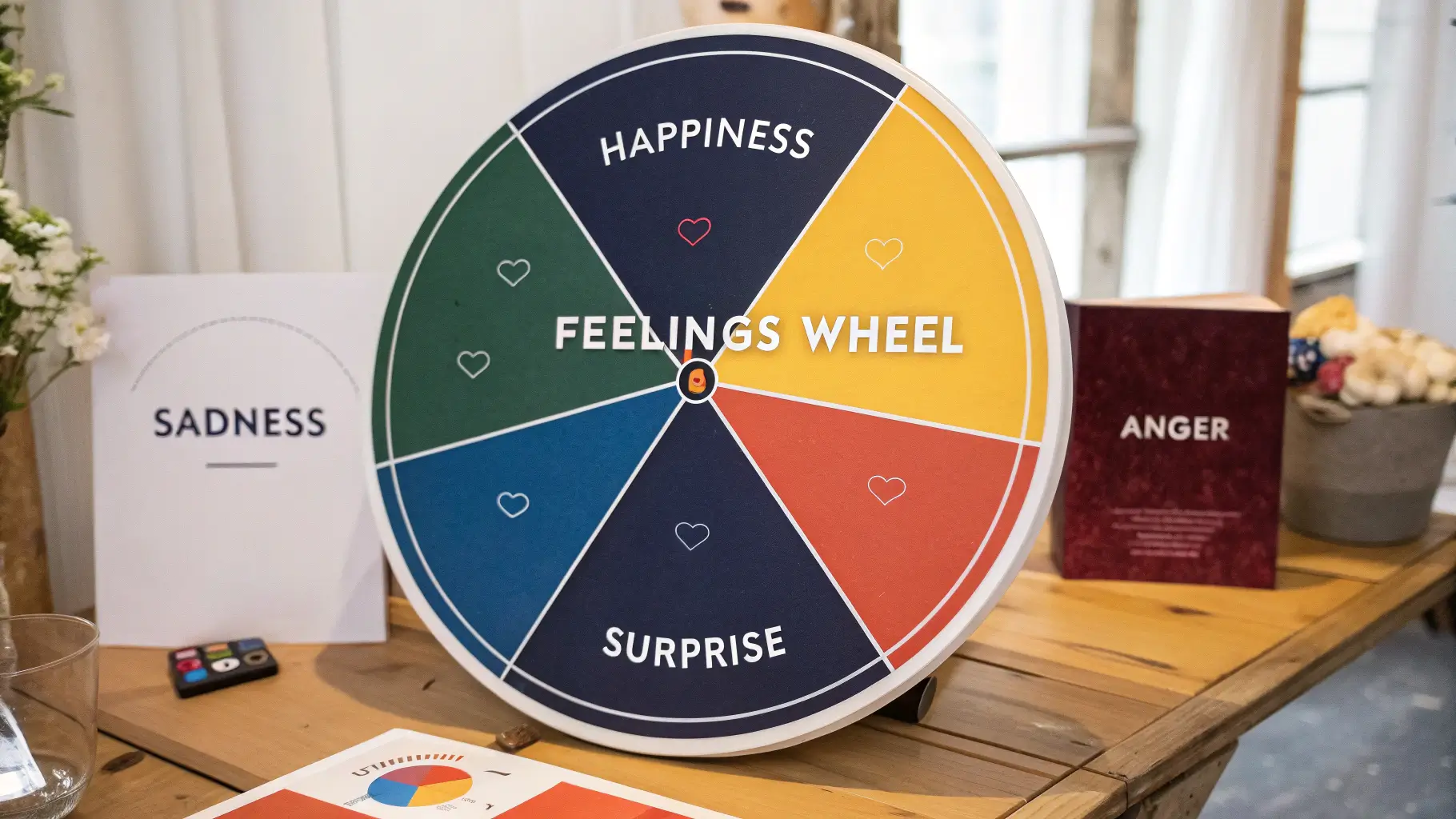
Unlocking Emotional Intelligence: A Comprehensive Guide to the Feelings Wheel
In today’s fast-paced world, understanding and managing our emotions is more crucial than ever. Emotional intelligence (EQ), the ability to perceive, use, understand, manage, and handle emotions, plays a significant role in our personal and professional lives. One powerful tool that can help us navigate the complex landscape of human emotions is the feelings wheel. This article provides a comprehensive guide to the feelings wheel, exploring its history, benefits, and practical applications.
What is the Feelings Wheel?
The feelings wheel, also known as the emotion wheel, is a visual tool that categorizes and organizes human emotions. It typically consists of concentric circles, with core emotions at the center and more nuanced feelings branching outwards. This design helps individuals identify and articulate their emotions with greater precision.
The most common version of the feelings wheel was developed by Dr. Gloria Willcox in the 1980s. Her model places six core emotions – happy, sad, angry, fearful, surprised, and disgusted – at the center. Subsequent iterations of the wheel, such as those popularized by Dr. Robert Plutchik, expand on these core emotions to include a wider range of feelings, reflecting the complexity of human experience. These wheels are often used in therapy, counseling, and self-help practices to enhance emotional awareness.
The History of the Feelings Wheel
While Dr. Gloria Willcox is widely credited with creating the modern feelings wheel, the concept of categorizing and visualizing emotions dates back much further. Philosophers and psychologists have long sought to understand and classify the vast spectrum of human feelings. Early attempts at emotion mapping laid the groundwork for the development of tools like the feelings wheel.
Dr. Willcox’s contribution was to create a practical and accessible tool that could be easily used by individuals to explore their emotional landscape. Her feelings wheel provided a framework for identifying and understanding emotions, making it easier for people to communicate their feelings and develop greater self-awareness. Other psychologists, such as Robert Plutchik, built on this foundation, creating more complex models that reflect the multifaceted nature of human emotion. The evolution of the feelings wheel reflects the ongoing quest to better understand and manage our emotional lives.
Benefits of Using the Feelings Wheel
The feelings wheel offers a multitude of benefits, making it a valuable tool for personal growth and emotional well-being. Here are some key advantages:
- Enhanced Emotional Awareness: The feelings wheel helps individuals become more aware of their emotions by providing a structured framework for identifying and labeling them.
- Improved Communication: By using the feelings wheel, people can articulate their emotions more clearly and effectively, leading to better communication in relationships and professional settings.
- Greater Self-Understanding: Exploring the feelings wheel can lead to deeper self-understanding, as individuals gain insight into the underlying causes and patterns of their emotions.
- Reduced Emotional Reactivity: With increased emotional awareness, individuals can learn to manage their emotions more effectively, reducing impulsive reactions and promoting more thoughtful responses.
- Increased Empathy: Understanding one’s own emotions can foster greater empathy for others, as individuals become more attuned to the emotional experiences of those around them.
How to Use the Feelings Wheel
Using the feelings wheel is a simple yet powerful process. Here’s a step-by-step guide:
- Identify the Core Emotion: Start by identifying the core emotion you are experiencing. This might be happiness, sadness, anger, fear, surprise, or disgust.
- Explore the Outer Layers: Once you’ve identified the core emotion, explore the outer layers of the feelings wheel to find more specific and nuanced feelings that resonate with your experience.
- Reflect on Your Feelings: Take time to reflect on the emotions you’ve identified. Consider what might be causing these feelings and how they are impacting your thoughts and behaviors.
- Communicate Your Feelings: Use the language of the feelings wheel to communicate your emotions to others in a clear and effective manner.
- Practice Regularly: The more you use the feelings wheel, the more adept you will become at identifying and managing your emotions. Make it a regular part of your self-reflection practice.
For example, if you are feeling angry, you might explore the outer layers of the wheel to discover that you are also feeling frustrated, irritated, or resentful. Identifying these nuances can help you better understand the root cause of your anger and develop more effective coping strategies. [See also: Coping Strategies for Anger Management]
Different Types of Feelings Wheels
While the basic concept of the feelings wheel remains consistent, there are several variations available, each with its own unique features and benefits. Some common types include:
- Willcox’s Feelings Wheel: The original feelings wheel developed by Dr. Gloria Willcox, featuring six core emotions at the center.
- Plutchik’s Wheel of Emotions: A more complex model developed by Dr. Robert Plutchik, which includes eight basic emotions and their various combinations.
- The Gottman Institute’s Feelings Wheel: A feelings wheel designed specifically for couples, focusing on emotions that are relevant to relationship dynamics.
- Customized Feelings Wheels: Some therapists and counselors create customized feelings wheels tailored to the specific needs of their clients.
Choosing the right feelings wheel depends on your individual needs and preferences. Some people prefer the simplicity of Willcox’s model, while others find the complexity of Plutchik’s wheel more helpful. Experiment with different versions to find the one that works best for you. [See also: Understanding Relationship Dynamics]
Practical Applications of the Feelings Wheel
The feelings wheel can be applied in a variety of settings, including:
- Therapy and Counseling: Therapists and counselors use the feelings wheel to help clients identify and process their emotions, leading to greater self-awareness and emotional healing.
- Education: Educators can use the feelings wheel to teach students about emotional literacy, helping them develop the skills they need to manage their emotions and build healthy relationships.
- Workplace: The feelings wheel can be used in the workplace to improve communication, reduce conflict, and foster a more supportive and emotionally intelligent work environment.
- Personal Development: Individuals can use the feelings wheel as a tool for self-reflection and personal growth, helping them develop greater self-awareness and emotional resilience.
For example, in a workplace setting, a team leader might use the feelings wheel to facilitate a discussion about team dynamics. By encouraging team members to identify and express their emotions, the leader can create a more open and collaborative environment. [See also: Building a Collaborative Work Environment]
The Feelings Wheel and Emotional Intelligence
The feelings wheel is a powerful tool for developing emotional intelligence. By enhancing emotional awareness, improving communication, and fostering self-understanding, the feelings wheel can help individuals cultivate the skills they need to succeed in all areas of life. Emotional intelligence is not just about understanding emotions; it’s about using that understanding to make better decisions, build stronger relationships, and lead a more fulfilling life. The feelings wheel is a valuable resource for anyone seeking to enhance their emotional intelligence and unlock their full potential.
Criticisms and Limitations of the Feelings Wheel
While the feelings wheel is a valuable tool, it is important to acknowledge its limitations. Some critics argue that the feelings wheel oversimplifies the complexity of human emotions, reducing them to a limited set of categories. Others point out that the feelings wheel may not be culturally sensitive, as emotions are expressed and interpreted differently across cultures. Additionally, some individuals may find it difficult to accurately identify and label their emotions using the feelings wheel.
Despite these limitations, the feelings wheel remains a useful tool for many people. It is important to use the feelings wheel as a starting point for exploration, rather than a definitive guide to emotions. Consider the cultural context and individual differences when interpreting emotions, and be open to exploring the nuances of your own emotional experience. [See also: Cultural Sensitivity in Emotional Expression]
Conclusion
The feelings wheel is a valuable tool for unlocking emotional intelligence and enhancing personal well-being. By providing a structured framework for identifying and understanding emotions, the feelings wheel can help individuals improve communication, foster self-understanding, and reduce emotional reactivity. Whether you are a therapist, educator, workplace leader, or simply someone seeking to enhance your emotional intelligence, the feelings wheel can be a powerful resource for personal growth and development. Embrace the feelings wheel as a tool to navigate the complex landscape of human emotions and unlock your full potential. Understanding the feelings wheel can be a significant step toward better emotional health. The feelings wheel provides a visual aid to help clarify what you are feeling. Using a feelings wheel consistently can improve your emotional vocabulary. Ultimately, using the feelings wheel can lead to more fulfilling relationships and a deeper understanding of yourself. The feelings wheel is a fantastic resource.

